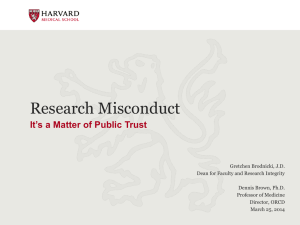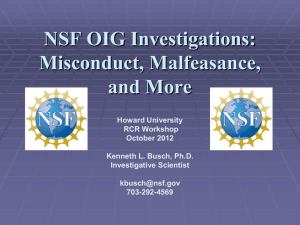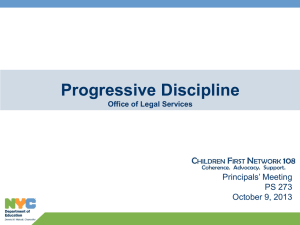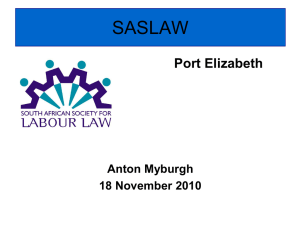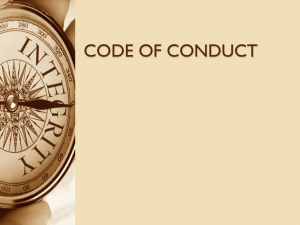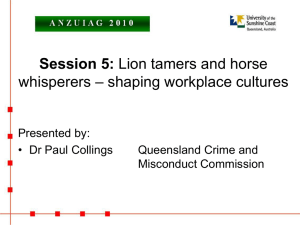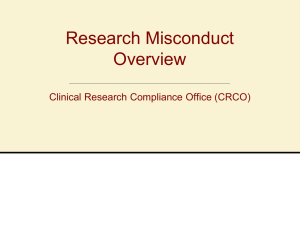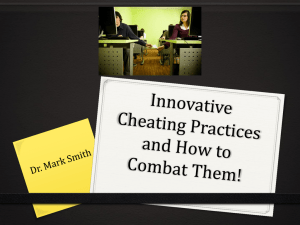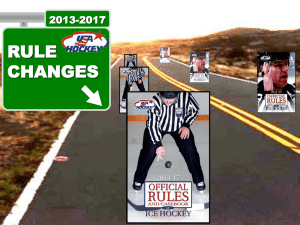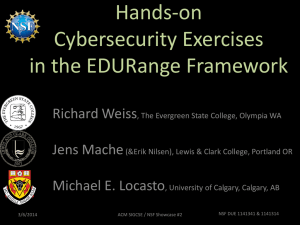Academic Integrity in the Classroom and Professional Activities
advertisement
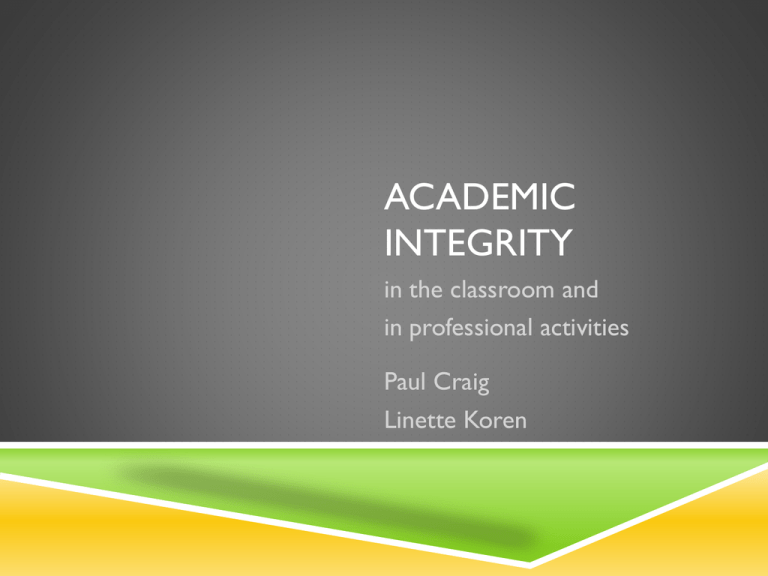
ACADEMIC INTEGRITY in the classroom and in professional activities Paul Craig Linette Koren Academic Integrity in the Classroom and in Professional Activities Date: Thursday, May 26th Time: 10:00AM - 12:00PM (Running Time: 2 hours) Location: Salon B Presenters: Paul Craig, Linette Koren Personal integrity is a core essential in the academic community. Our existence is based on the trust of parents who send their children to RIT, as well as the trust of our partners (such as Rochester General Hospital and federal funding agencies) who support our professional efforts. The demand for excellence by students and faculty also creates pressure to produce, which can lead to a temptation to take shortcuts in our 'cut-and-paste' world. To grow as an institution, RIT must maintain the highest standards of academic integrity, which means we need to communicate those standards among students and faculty. We will explore current norms for academic integrity as defined by the National Academy of Science and consider how to apply those standards in our learning and teaching. ACTION for Attendees: Please bring a printed copy of two or three class syllabi so that we can look at them together in a pair-share setting toward the end of our session. SCHEDULE 10:00 NSF policies on misconduct in research (Paul) 10:15 Case students on research misconduct (interactive) 10:30 Presentation on using EndNote Web (Linette) 10:50 High tech cheating (Linette) 11:20 Questions/comments on high tech cheating (interactive) 11:30 Preparing an effective syllabus designed to limit cheating (Paul) 11:40 Modifying your own syllabi to reflect these approaches (Interactive) NSF POLICIES ON RESEARCH MISCONDUCT NSF Office of Inspector General (http://www.nsf.gov/oig/misconscieng.jsp) Regulations can be found at 45 CFR 689 (http://www.nsf.gov/oig/misconscieng.jsp) TYPES OF MISCONDUCT Fabrication Falsification Plagiarism Does not include honest error or differences of opinion 45 CFR Part 689 – Research Misconduct FABRICATION making up data or results and recording or reporting them 45 CFR Part 689 – Research Misconduct FALSIFICATION manipulating research materials, equipment, or processes, or changing or omitting data or results such that the research is not accurately represented in the research recordmaking up data or results and recording or reporting them 45 CFR Part 689 – Research Misconduct PLAGIARISM the appropriation of another person’s ideas, processes, results or words without giving appropriate credit 45 CFR Part 689 – Research Misconduct TURNITIN.COM Papers that have been submitted Papers pulled from the Internet Papers from paper mills An archived copy of the Internet Books, newspapers and journals Proprietary database TURNITIN.COM DOES NOT FIND Grant proposals that have been submitted to NSF, NIH, DOE or similar sources These organizations keep their own proprietary databases NSF Fastlane gives you access to abstracts only NSF INVESTIGATION OF RESEARCH MISCONDUCT Inquiry – a fact-finding mission Investigation - a formal development, examination and evaluation of a factual record to determine whether research misconduct has taken place, to assess its extent and consequences, and to evaluate appropriate action. 45 CFR Part 689 – Research Misconduct RESEARCH MISCONDUCT A departure from normal practices Intentional Knowing Reckless 45 CFR Part 689 – Research Misconduct NSF ACTIONS. GROUP I A letter of reprimand Special approvals required for submission Additional institutional oversight 45 CFR Part 689 – Research Misconduct NSF ACTIONS. GROUP II Suspension of an active award Special reviews of all requests for funding from the individual or the institution A correction to the research record 45 CFR Part 689 – Research Misconduct NSF ACTIONS. GROUP III Termination of an active award Prohibit the individual from reviewing grants, advising or consulting on grants for a specified of time Debar or suspend the individual or the institution for a specified period of time 45 CFR Part 689 – Research Misconduct BASIS FOR NSF ACTIONS Seriousness of the offense The degree to which the misconduct was knowing, intentional, or reckless An isolated incident or part of a pattern Impact on the research record, subjects, other researchers, institutions or the public welfare Other relevant actions 45 CFR Part 689 – Research Misconduct CASE STUDY #1 A graduate student, working on a project that involves extensive DNA sequencing, provides his mentor with a computer generated sequence of a gene. The student tells his mentor that the sequence determination has involved complete analysis of both strands of the DNA molecule. Over the next several months, it is determined that not all of the sequence data reflects analysis of both DNA strands. Indeed, follow-up work by a postdoctoral in the laboratory reveals several mistakes in the sequence. The student in question admits to misleading his mentor and, following appropriate investigation, is convicted of scientific misconduct and dismissed from the graduate program. The mentor realizes that the student presented some of the erroneous data at a regional scientific meeting. Proceedings of the meeting were not published but abstracts of all of the works presented were distributed to approximately 100 meeting participants. In addition the student, with the mentor's permission, sent the sequence by electronic mail to three other laboratories. What, if any, responsibility does the faculty mentor have with regard to disclosing the above developments? What, if anything should the mentor do about the prematurely released data? Under these circumstances, what is the potential for harm coming from this incident of scientific fraud? Who might be harmed? http://research-ethics.net/topics/research-misconduct/#discussion CASE STUDY #2 You are an editor for the Journal of Novel Diagnostics.Your recently handled a manuscript that compared two new diagnostic tests for detection of a genetic defect. Test 1 is marketed by Genetix, Inc. and test 2 is marketed by Probes Unlimited. The manuscript concludes that test 1 is superior in terms of reliability and accuracy. Following peer review and minor revision, you accept the paper and it appears in print. Shortly after publication, you receive a letter from the Vice President for Research at Probes Unlimited. She claims that examination of the methods section of the paper reveals that the authors used test 2 in a manner that significantly deviates from the instructions provided by Probes Unlimited. Moreover, she claims that the senior author on the paper has previously received research grants from Genetix, Inc. Is this "sloppy science" or scientific fraud. What course of action do you take? http://research-ethics.net/topics/research-misconduct/#discussion CASE STUDY #3 Dr. Hickory submits a grant application to a federal funding agency. When he receives the summary statement review of the grant application, he finds that it has been criticized on several grounds and that it has received a score which will prevent the application from being funded. He decides to do more experiments to generate preliminary information and indefinitely postpones resubmitting the grant application. Approximately 18 months later, Dr Hickory is asked to serve as an ad hoc reviewer for a research grant submitted to a private foundation. The topical area of the grant is closely aligned with Dr. Hickory's area of expertise. It turns out that the principal investigator of this application, Dr. Poplar, was a member of the panel that previously reviewed Hickory's above-referenced grant. In reading the introductory section of the grant application, Dr. Hickory realizes that the structure and content of this section is strikingly similar to his previously submitted unfunded grant application. In fact there are several areas of the introduction where wording is virtually identical to his initial grant application. Moreover, several of the experiments proposed in the application to the private foundation are quite similar (but not identical) to the ones he had previously proposed. Dr. Hickory wonders what he can and should do about this situation. He comes to you for advice. What advice do you give him? http://research-ethics.net/topics/research-misconduct/#discussion OTHER RESOURCES Organization Link NIH Office of Research Integrity http://ori.hhs.gov/ U.S. Dept. of Education http://www2.ed.gov/legislation/FedRegister/ot her/2005-4/110205d.html U.S. Dept. of Energy http://management.energy.gov/policy_guidance /626.htm U.C. Berkeley http://vcresearch.berkeley.edu/researchpolicies/research-compliance/researchmisconduct ENDNOTE WEB EndNote Web is a citation management program that allows you to collect, organize, format, and share your references Web-based for access wherever you are References can be imported directly from library databases or added manually Citation style is easily changed In-text citations are also formatted if using MS Word (requires plug-in) http://infoguides.rit.edu/endnoteweb HIGH TECH CHEATING Common Sense Media video http://www.youtube.com/watch?v=Z98zgsatwAw WHAT IS HIGH TECH CHEATING? Cheating using gadgets and technologies such as cell phones, MP3 players, calculators, and other PDA devices Using web sites that offer the means to cheat (paper mills, textbook problem solutions, test sharing sites) Using technology (such as YouTube videos) to learn about and then implement low tech solutions (soda bottles, t-shirts, baseball caps, pens) DO TEENS CONSIDER THIS CHEATING? Searching the Internet to find a teacher’s manual, or the publisher’s solutions to problems from a text you are using? (N=1,013) Yes: Serious Offense: 36% Yes: Minor Offense: 28% No, but because not permitted: 20% Just helping self or friend: 16% IS THIS CHEATING? Take pictures of quiz/test questions to send to friends before they take the quiz/test? (N=1,013) Yes, serious offense: 51% Yes, minor offense: 26% No, but not permitted: 13% Just helping self/friend: 11% PAPER MILL SITES Oppapers.com Allfreeessays.com Term Papers Lab WriteMyEssay.com Cheathouse.com TEXTBOOK SOLUTIONS Cramster.com Course Hero Student Testimonials: I like that I ask questions and get help in a short time. Nothing but straight A's thanks to Cramster. Man I love Cramster. Step by step solutions rock my world! Cramster does a better job explaining than my professor! If Cramster ruled the world, all problems would be solved TEST SITES Koofers.com VIDEOS YouTube videos are a high tech means to show students how to cheat in high tech and low tech ways Soda bottles T-shirts Pens http://www.youtube.com/watch?v=91lQK5SCzlQ http://www.youtube.com/watch?v=BZg_G8djiHY&feature=related THE TECHNOLOGIES Smart phones have Internet access, voice recording and playback options, notetaking apps, cameras, and text messaging capabilities MP3 players play more than music; they can have audio files of student recorded data as well as lists Calculators are programmable and can hold text, formulas, and more (TIs are used for SATs and AP exams) Wireless earphone and microphones allow for whispering questions and answers SMART PHONES have Internet access voice recording and playback options note taking apps cameras text messaging capabilities MP3 PLAYERS Can store: audio files Data SCIENTIFIC/GRAPHING CALCULATORS Can hold: Text Formulas WIRELESS EARPHONES AND MICROPHONES Can allow for: Whispering of answers PREVENTING HIGH TECH CHEATING Ethics Adopt or enforce an honor code Discuss all types of academic dishonesty in class State your policies clearly in syllabus PREVENTING HIGH TECH CHEATING Best practices Require students show their work in exams; especially math and physics (offer partial credit for this) Don’t give exams that require memorization which leads to the creation of “cheat sheets” Don’t reuse exams – these end up in test bank web sites PREVENTING HIGH TECH CHEATING Technological methods Use high-tech detection methods such as Turnitin.com Limit what is allowed to enter the exam room no cell phones, iPods, PDAs, backpacks, etc. Turn off the wireless network in your classroom PREVENTING HIGH TECH CHEATING Low tech methods Consider a dress code no baseball caps, zippered hoodies Establish a no food/drink policy no candy, gum, soda Share what’s happening in your classroom with others EFFECTIVE SYLLABUS DESIGN Provide information State policies clearly Instruct about academic integrity policies and consequences PROVIDING INFORMATION Course information Instructor information Textbook and other reading materials Course description and objectives Calendar and attendance policies Grading Altman & Cashin, 1992 POLICIES Excused and unexcused absences Accessibility and academic accomodations American with disabilities act Academic Integrity Issues UNC-Chapel Hill ACADEMIC INTEGRITY Define plagiarism – RIT library resources Duplicate submission Rules of collaboration – when is it okay or encouraged? Acceptable and unacceptable resources – can the students use old exams when they are completing a take-home exam? Consequences – university policies UNC-Chapel Hill AVOIDING PLAGIARISM Teach and demonstrate proper citations in the classroom Provide resources for citation software such as Endnote Web Written assignments Limited topics Require a proposal, outline and rough draft over the course of the term Regularly reinforce RIT’s policies on plagiarism Craig, Federici & Buehler LINKS University of Delaware Center for Teaching and Learninghttp://cte.udel.edu/instructional-topics/designingcourses/designing-learning-centered-syllabus.html Cornell Center for Teaching Excellencehttp://www.cte.cornell.edu/faculty/materials/CourseMaterials Checklist.pdf University of Minnesota Center for Teaching and Learning http://www1.umn.edu/ohr/teachlearn/tutorials/syllabus/resources/checkl ist/index.html The Teaching Center at Washington University in St. Louis http://teachingcenter.wustl.edu/preparing-syllabus-checklist LINKS HB Altman, WE Cashin. IDEA Paper No. 27, Center for Faculty Evaluation and Development. A Divison of Continuing Education, Kansas State University. September, 1992. http://honolulu.hawaii.edu/intranet/committees/FacDevCom/guidebk/tea chtip/writesyl.htm Honor in the syllabus. UNC-Chapel Hill. http://honor.unc.edu/index.php?option=com_content&view=article&id= 106&Itemid=149 PA Craig, E Federici, MA Buehler. Instructing Students in Academic Integrity. Journal of College Science Teaching 40: 50-55 (2010)
